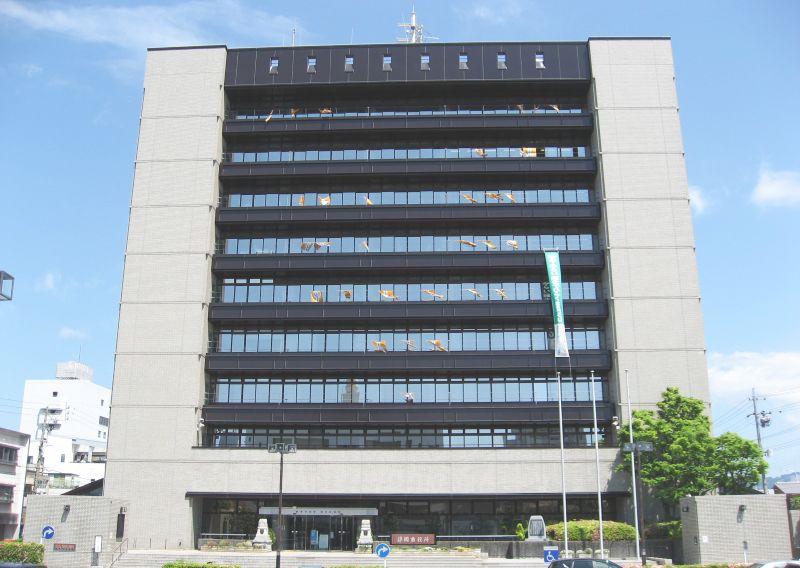|
Chibi Maruko Chan
is a shōjo manga series written and illustrated by Momoko Sakura. The series depicts the simple, everyday life of Momoko Sakura, a young girl everyone calls ''Maruko'', and her family in suburban Japan in the year 1974. Maruko is a troublemaker, and every episode recounts Maruko's trouble and how she and her friends succeed in solving the situation. The series is set in the former of Irie District (入江町), Shimizu, now part of Shizuoka City, birthplace of its author. The first story under the title "Chibi Maruko-chan" was published in the August 1986 edition of the shōjo manga magazine '' Ribon''. Other semi-autobiographical stories by the author had appeared in ''Ribon'' and ''Ribon Original'' in 1984 and 1985, and were included in the first "Chibi Maruko-chan" tankōbon in 1987. The author first began writing and submitting strips in her final year of senior high school, although Shueisha (the publisher of ''Ribon'' and ''Ribon Original'') did not decide to run ... [...More Info...] [...Related Items...] OR: [Wikipedia] [Google] [Baidu] |
Tankōbon
is the Japanese Japanese may refer to: * Something from or related to Japan, an island country in East Asia * Japanese language, spoken mainly in Japan * Japanese people, the ethnic group that identifies with Japan through ancestry or culture ** Japanese diaspor ... term for a book that is not part of an anthology or corpus. In modern Japanese, the term is most often used in reference to individual volumes of a manga series: most series first appear as individual chapters in a weekly or monthly List of manga magazines, manga anthology with other works before being published as volumes containing several chapters each. Major publishing Imprint (trade name), imprints for include Jump Comics (for serials in Shueisha's ''Weekly Shōnen Jump'' and other Jump (magazine line), ''Jump'' magazines), Kodansha's Weekly Shōnen Magazine, Shōnen Magazine Comics, and Shogakukan's Shōnen Sunday Comics. Japanese comics (manga) manga came to be published in thick, phone book, phone- ... [...More Info...] [...Related Items...] OR: [Wikipedia] [Google] [Baidu] |
Shimizu-ku, Shizuoka
is the easternmost of the three wards of the city of Shizuoka in Shizuoka Prefecture, Japan. History Shimizu-ku was created on April 1, 2005, when Shizuoka became a city designated by government ordinance (a "designated city"). Its area is almost identical to former Shimizu city, which merged with Shizuoka city on April 1, 2003. Shizuoka annexed the town of Kanbara from Ihara District on March 31, 2006, and the town of Yui on November 1, 2008, adding these former municipalities to Shimizu-ku. Since ancient times, Shimizu thrived as a harbor town due to its good natural harbor. In addition, five post stations of Tōkaidō were located in Shimizu: (Kanbara-juku, Okitsu-juku, Ejiri-juku, and Yui-shuku, all of which brought prosperity to the area during the Edo period. After the Meiji Restoration, an Imperial decree in July 1899 established Shimizu as an open port for trading with the United States and the United Kingdom.US Department of State. (1906) ''A digest of international ... [...More Info...] [...Related Items...] OR: [Wikipedia] [Google] [Baidu] |
Tarako
, known under the professional name , is a Japanese actress, voice actress and singer.Doi, Hitoshi.Tarako. ''Seiyuu Database''. July 5, 2010. Her debut role was as a preschooler on ''Urusei Yatsura''. She is currently employed by the talent management firm Troubadour Musique Office. Filmography Animation TV * ''Fushigi na Koala Blinky'' (Mark) * ''Anpanman'' (Frankenrobo) * ''Chibi Maruko-chan'' (Momoko Sakura – Marukochan) * ''Coji-Coji'' (Suzie) * ''Combat Mecha Xabungle'' (Chill) * '' Danganronpa 3: The End of Hope's Peak High School'' (Monokuma) * ''Ganbare, Kickers!'' (Taichi Ohta) * '' Hunter × Hunter (1999)'' (Melody) * ''InuYasha'' and '' Hanyo no Yashahime'' ( Kirara) * ''Kimba the White Lion'' (Lulu, other voices) * ''Kindaichi Case Files'' (Asuka Minatoya) * ''Magical Tarurūto-kun'' (Tarurūto) * '' Meitantei Kageman'' (Kageman) * ''Mikan Enikki'' (Mikan) * '' Mushiking: King of the Beetles'' (Chibi King) * ''NG Knight Ramune & 40'' (Hebimetako) * ''Nichijou' ... [...More Info...] [...Related Items...] OR: [Wikipedia] [Google] [Baidu] |
Manga Iconography
Japanese manga has developed its own visual language or iconography for expressing emotion and other internal character states. This drawing style has also migrated into anime, as many manga stories are adapted into television shows and films. While this article addresses styles from both types of output, the emphasis here is on the manga origins for these styles. The popular and recognizable style of manga is very distinctive. Emphasis is often placed on line over form, and the storytelling and panel placement differ from those in Western comics. Impressionistic backgrounds are very common, as are sequences in which the panel shows details of the setting rather than the characters. Panels and pages are typically read from right to left, consistent with traditional Japanese writing. Iconographic conventions in manga are sometimes called (or ''mampu''). Because manga is a diverse art form, however, not all manga artists adhere to the conventions most popularized in the West th ... [...More Info...] [...Related Items...] OR: [Wikipedia] [Google] [Baidu] |
COVID-19 Pandemic
The COVID-19 pandemic, also known as the coronavirus pandemic, is an ongoing global pandemic of coronavirus disease 2019 (COVID-19) caused by severe acute respiratory syndrome coronavirus 2 (SARS-CoV-2). The novel virus was first identified in an outbreak in the Chinese city of Wuhan in December 2019. Attempts to contain it there failed, allowing the virus to spread to other areas of Asia and later worldwide. The World Health Organization (WHO) declared the outbreak a public health emergency of international concern on 30 January 2020, and a pandemic on 11 March 2020. As of , the pandemic had caused more than cases and confirmed deaths, making it one of the deadliest in history. COVID-19 symptoms range from undetectable to deadly, but most commonly include fever, dry cough, and fatigue. Severe illness is more likely in elderly patients and those with certain underlying medical conditions. COVID-19 transmits when people breathe in air contaminated by droplets and ... [...More Info...] [...Related Items...] OR: [Wikipedia] [Google] [Baidu] |
Kodansha Manga Award
is an annual award for serialized manga published in the previous year, the event is sponsored by the publisher Kodansha. It is currently awarded in three categories: '' shōnen'', '' shōjo'', and general. The awards began in 1977, initially with categories for ''shōnen'' and ''shōjo''. The first award for the general category was in 1982, and the first children's category's award was in 2003. The children's category was merged into the ''shōnen'' and ''shōjo'' categories starting in 2015. Each winning work will be honored with a bronze statuette, a certificate and a prize of 1 million yen (about US$7,500). Recipients See also * List of manga awards This list of manga awards is an index to articles about notable awards for manga, comics or graphic novels created in Japan or using the Japanese language and conforming to a style developed in Japan in the late 19th century. Awards See als ... References * * External links Japanese official website {{Manga Indu ... [...More Info...] [...Related Items...] OR: [Wikipedia] [Google] [Baidu] |
Sazae-san
is a Japanese yonkoma manga series written and illustrated by Machiko Hasegawa. It was first published in Hasegawa's local paper, the , on April 22, 1946. When the ''Asahi Shimbun'' wished to have Hasegawa draw the four-panel comic for their paper, she moved to Tokyo in 1949 with the explanation that the main characters had moved from Kyūshū to Tokyo as well. The first ''Sazae-san'' strip run by the ''Asahi Shimbun'' was published on November 30, 1949. The manga dealt with everyday life and contemporary situations in Tokyo until Hasegawa retired and ended the series, with the final comic published on February 21, 1974. ''Sazae-san'' won the 8th Bungeishunjū Manga Award in 1962. An anime television adaptation by TCJ (later renamed Eiken) began airing in Japan in October 1969 and holds the Guinness World Record for the longest-running animated television series. It has also been adapted into a radio show, theatrical plays and songs. Plot In the beginning, Sazae was more in ... [...More Info...] [...Related Items...] OR: [Wikipedia] [Google] [Baidu] |
Merchandising
Merchandising is any practice which contributes to the sale of products to a retail consumer. At a retail in-store level, merchandising refers to displaying products that are for sale in a creative way that entices customers to purchase more items or products. In retail commerce, visual display merchandising means merchandise sales using product design, selection, packaging, pricing, and display that stimulates consumers to spend more. This includes disciplines and discounting, physical presentation of products and displays, and the decisions about which products should be presented to which customers at what time. Often in a retail setting, creatively tying in related products or accessories is a great way to entice consumers to purchase more. Merchandising helps to understand the ordinary dating notation for the terms of payment of an invoice. Codified discounting solves pricing problems including markups and markdowns. It helps to find the net price of an item after sing ... [...More Info...] [...Related Items...] OR: [Wikipedia] [Google] [Baidu] |
Fuji Network System
Fuji Network System (known in Japan as simply , FNS) is a Japanese television network operated by Fuji Television Network, Inc., part of the Fujisankei Communications Group. FNS distributes entertainment and other non-news television programmes to its 28 regional television stations. Distribution of national television news bulletins is handled by Fuji News Network Fuji News Network (FNN) is a Japanese commercial television network run by Fuji Television Network, Inc., part of the Fujisankei Communications Group. The network's responsibility includes the syndication of national television news bulletins to ..., another network set up by Fuji TV. Fuji Network System stations External links FNS Official site Television networks in Japan Television channels and stations established in 1969 Fuji TV {{Japan-tv-station-stub ... [...More Info...] [...Related Items...] OR: [Wikipedia] [Google] [Baidu] |
Fuji Television
JOCX-DTV (channel 8), branded as and colloquially known as CX, is a Japanese television station based in Odaiba today is a large artificial island in Tokyo Bay, Japan, across the Rainbow Bridge from central Tokyo. Odaiba was initially built in this area for defensive purposes in the 1850s. Reclaimed land offshore Shinagawa was dramatically expanded durin ..., Minato, Tokyo, Japan. Owned-and-operated station, Owned and operated by the it is the flagship (broadcasting), key station of the Fuji News Network (FNN) and the Fuji Network System. It is also known for its long-time slogan, ''"If it's not fun, it's not TV!"'' Fuji Television also operates three premium television stations, known as "Fuji TV One" ("Fuji TV 739"—sports/variety, including all Tokyo Yakult Swallows home games), "Fuji TV Two" ("Fuji TV 721"—drama/anime), and "Fuji TV Next" ("Fuji TV CSHD"—live premium shows) (called together as "Fuji TV OneTwoNext"), all available in High-definition television, ... [...More Info...] [...Related Items...] OR: [Wikipedia] [Google] [Baidu] |



.png)
.png)